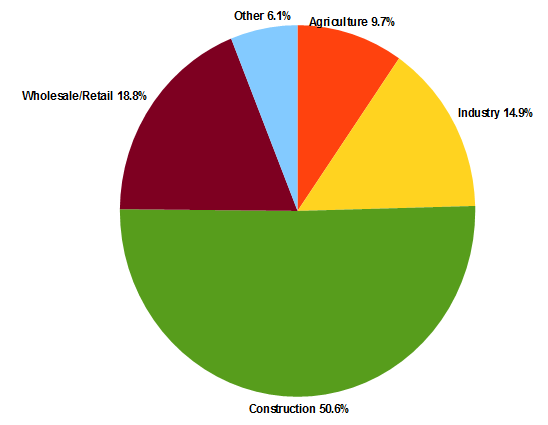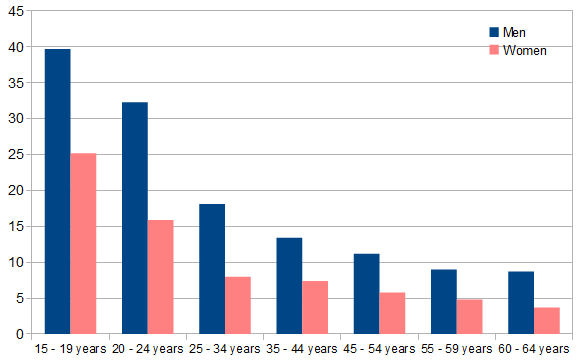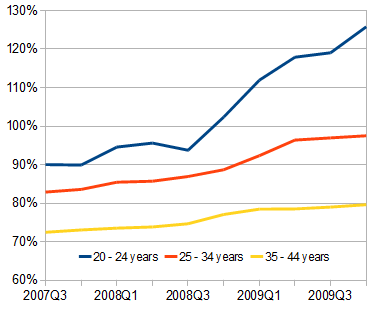Last week, the CSO’s latest Quarterly National Household Survey was released. This is the key source of information for those of us tracking Ireland’s unemployment crisis. There were some mixed signals in last week’s survey – this post highlights two areas that are central to understanding what’s happening in Ireland’s labour market at the moment.
Job losses come from just four sectors
Almost 95% of job losses in the last two years have come from less than half the economy. The economy shed 250,000 jobs between late 2007 and late 2009. Just over half of that has come from construction, with the wholesale/retail, manufacturing and agriculture sectors comprising just short of 20%, 15% and 10% respectively.
The rest of the economy – including about 670,000 private sector jobs and 500,000 public sector jobs – has almost completely escaped large-scale job losses. There were 1.16m people employed in these sectors in late 2007. By late 2009, that number had fallen to 1.15m. True, there are some differences within this group. For example, the tourism sector did lose 12% of its jobs during 2008 – but in fact bounced back almost 5% during 2009, despite the strength of the euro. The somewhat nebulous “Administrative and support services” sector has also fared badly. But overall, these sectors have escaped.
Incidentally, public sector employment looks to have finally levelled off. Having jumped 24,000 during 2008, numbers employed in the civil service, education and health fell by 400 during 2009, a fall in education offsetting a further rise in health. The sectors which are the source of the 250,000 jobs losses over the last two years are outlined in the graph below. (To reinforce the point, the “other” catch-all sector is large: from about four times the size of wholesale/retail to about ten times the size of agriculture.)

One can but hope, then, that Ireland’s unemployment crisis retains its relatively contained nature. The alternative, large-scale jobs losses in certain sectors slowly bleeding into the rest of the economy, would weigh on the economy for years to come.
Ireland’s running out of men
A different perspective on unemployment – one I’ve touched on before – is how the various age-gender cohorts have been affected in different ways. The second graph, below, shows unemployment rates for men and women for seven different age groups between 15 and 64. What’s remarkable is that, from the age of 25 upwards, the unemployment rate for even the most affected group of women (25-34) is lower than for the least affected cohort of men (60-64).

This is not a trick of statistics – i.e. it’s not the case the case that female unemployment rates are pushed down by women counting themselves out of the labour market through either emigration or full-time domestic duties. In fact, the gender gap in unemployment is all the more remarkable given that the female labour force has actually grown by 23,000 in the last two years. (The male 25-64 labour force is largely unchanged.) There are only 10,000 fewer women at work now than two years ago.
While good news for women at the moment, this gender gap has potentially huge implications for Ireland, Inc. The graph below shows the ratio of women to men at work for three key demographics between the ages of 20 and 44. As you can see, the general trend is upwards – itself not a concern if it represents a long-term normalisation of the labour market, with more women in paid employment for more of their careers. However, what is a concern is the fact that, among Ireland’s 20-somethings, men can no longer find a job. There are now 25% more women at work in the 20-24 age group than men.

An Ireland where young men can’t get a job is likely to become before too long an Ireland with significant emigration of young men. Already there are 70,000 fewer men under 35 in Ireland than two years ago. The result is that there are now more women in Ireland between the ages of 20 and 34 than there are men – the key household-forming age.
And an Ireland where men are leaving is likely to see some women follow them too. Even if they stay, mathematically there is no way to form 150,000 new families with only 130,000 men (at least not using the traditional definition of family). And so Ireland becomes China inverted – too many women and not enough men. That would mean our generation-long boast, of having the youngest population in Europe, disappears in a few short years. And with it, the extra decade or two we had bought ourselves before our pensions timebomb explodes.
Given the nature of the sectors from which Ireland’s newly unemployed are coming, the solution will come from (re)training and upskilling. No silver bullet sector will emerge, looking to employ 200,000 men who are largely semi-skilled and without higher education. Their reintegration into the labour market will more than likely be slow and steady so there’s no time to waste.
Is Ireland running out of men? ,
[…] […]
Joseph ,
Hi Ronan – good post as always. Re – “And with it, the extra decade or two we had bought ourselves before our pensions timebomb explodes.”.
By pensions timebomb do you mean the ratio of the number of people in work ‘supporting’ the retired?
Raoul Philipse ,
Sounds like ireland is the place to be :).
Irish people no better off now than during Black Death, and other stories | Ronan Lyons ,
[…] Browse in Irish Economy « It’s not raining men – Ireland at risk of becoming the opposite of China […]
Forbes.com rates Ireland as no. 1 in 'World's Worst Countries For Jobs.' - Page 3 ,
[…] […]
C M ,
It’s pretty ridiculous to compare Ireland with China in terms of gender imbalance. China has a SERIOUS PROBLEM, because of the female infanticide and their ridiculous communist laws. They are now short 29 million women !
As far as I know, nobody is aborting babies or leaving newborns to die in Ireland because they are male.
Ronan Lyons ,
Hi “C M”,
The point is not about why the imbalance is there – it’s about the relative size of the imbalance. You might think 29 million women is a big number, but in terms of China’s overall population, it’s about 2%. The same proportion of Ireland’s population would be 100,000. By the time of this article, Ireland had lost 70,000 men due to the recession, resulting in a shortage of men relative to women.
Ireland’s boast of having Europe’s young won’t last long if there aren’t the people here to form families.